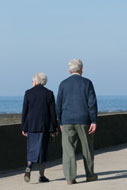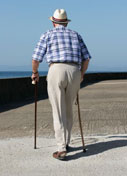
Older age is an inevitable dilemma
that everyone has to encounter. With older age accompanies many
changes. Such changes could affect the ability and way an individual
engages in a basic daily activity such as walking. Problems in
performing the basic task of walking may lead to gait changes in the
older adult population, but consider the further difficulties and
changes that could arise in the gait of an older adult who suffers
hemiplegia secondary to a cerebral vascular accident/stroke. As
physical therapists we should not only be aware of the development
of gait in older adults, but we should also be aware of the
additional needs and challenges older adult stroke victims will
encounter with gait .
With older age various factors can contribute to the developmental
changes of the older adult gait. Visual deficits and cognitive
impairment are huge factors that can affect such things as balance,
motor decision and motor execution (Cwikel et al. 1995). With an
increase in age there is a decrease in ability to adjust to minor
losses of equilibrium (Cummings et al. 1989 in Cwikel et al. 1995).
There is also a decrease in regular physical exercise which is
associated with a lower step length and a decrease in the ability to
turn the head while walking (Cwikel et al. 1995). Movement for older
adults is also more attention-demanding and requires more time for
execution (Diggles 1993 in Lajoie et al.)
Many changes occur in the gait of the older adult compared to that
of the younger adult. It is important for us to know what these
changes are so that we might be able to help these older adults in
maximizing efficiency in their gait through the use of inertia and
gravity (Lewis 1989). In the study of Nagasaki et al. (1996) they
found such changes. They calculated the Walk Ratios of 1,134
subjects age 65 and older. The Walk Ratio, which is a good indicator
of an altered walking pattern, is calculated by taking the step
length and dividing it by the step rate. From their study, they
concluded older adults walked slower and with relatively shorter
steps, because they obtained smaller Walk Ratios. They saw such
reasons for this outcome in the gait patterns of their older adults
characterized by a shorter step length, a longer stance and double
stance time relative to the walking cycle, a diminished rotation of
the hip, knee, and ankle joints and a decrease in the ability to
vertically elevate the heel and toe resulting in an appearance of a
shuffling gait. From these findings we can now develop a treatment
strategy that can incorporate such things as strength, endurance,
and flexibility to help make walking more efficient for these older
adults (Lewis 1989).
Lajoie et al. (1996) also drew similar conclusions as Nagasaki et
al. (1996) in their study of gait characteristics of eight younger
adults compared to eight older adults. Their studies concluded older
adults adopted a slower walking speed and a shorter stride length
than younger adults. The walking speed for older adults was 1.10 m/s
vs. 1.39 m/s for the younger adults. The older adults had a 1.25 m
stride length vs. a 1.50 m stride length for the younger adults. The
older adults also had a longer cycle duration, a slower cadence
time, and a greater percentage of time in double support compared to
the younger adults. The older adult’s cycle duration was 1.15 s vs.
1.10 s.; their cadence was 105 steps/min. vs. 109 steps/min., and
the percentage time spent in double support for the older adults was
30.9% vs. 26.7%. This time spent in double support was considered
one of the most important parameters when studying locomotion by
Ferrandez (1988), because the double support phase is dependent on
the total duration of the walking cycle and will provide a better
comparison when comparing the older adult’s gait with the younger
adult’s. Though the above results failed to reach significance
statistically, the results further supports the same conclusions
other researches such as Rubino (1993) agree with.
Lewis (1989) lists similar gait changing characteristics for older
adults which included fewer automatic movements, a decrease in speed
and amplitude of automatic movements, an increase in muscle activity
in the gait cycle, less accuracy and slower movement especially in
the hip, a decrease swing-to-stance ratio, a decrease vertical
displacement, a broader stride width, an increase toe-floor
clearance, a decrease heel-floor angle, a slower cadence, a decrease
rotation of the hips and the shoulders, some mild rigidity and some
abnormalities in posture. To these characteristics she attributed
such factors as a decrease in the range of motion of the joints, a
decrease in strength in the skeletal and muscular systems along with
an increase in energy consumption as possible underlying factors.
In many studies of gait in older adults there are controversial
issues about how researchers define the term “older adult” (Woollacott
1986). In the studies mentioned earlier, the subjects were older
adults that were screened physically and mentally but not as in
depth as a study conducted by Gabell and Nayak (1984). A good reason
for a need of a reference group free of pathological disorders is to
evaluate the progress in such areas as medications or physical
therapy (Ferrandez 1988). Gabell and Nayak (1984) set out to obtain
such a group and had strict criteria in obtaining their older adults
for their gait study. This resulted in different results compared to
their peers. Their 32 older adult subjects were age 64 and greater &
had no disorders of the musculoskeletal, neurological, or
cardiovascular systems. They had no severe bilateral visual
impairment, or glaucoma, no history of falls, and no use of a
walking aid. From their study they found insignificant differences
in measuring the variability of gait in four parameters which
included step length, stride time, stride width, and double support
time when comparing these older adults with younger adults. From
these results they concluded that any increase in variability
occurring in the gait cycle of older adults is not normal, but due
to pathological causes (Gabell & Nayak 1984). This is somewhat
inconsistent with other peer results, but we should realize that the
older adults in this study that met the above criterion are really
somewhat hard to find and are unrepresentative of the older age
group (Woollacott 1986).

The changes in gait already affect the ability for the normal older
adult to perform activities as well as they used to, but imagine the
decrease in performance that would further arise when an individual
suffers hemiplegia secondary to a stroke. A stroke is normally
caused by a blockage of blood circulation to the brain or
hemorrhaging into the brain from a ruptured blood vessel. These
disturbances could result in hemiplegia which is paralysis to one side of the body.
The gait pattern in an older adult that suffers hemiplegia differs
greatly from that of a normal older adult. We should really be aware
of the great difficulty and frustration a stroke victim endures in
trying to produce these movements involved in gate. Rubino (1993)
describes the walking of an individual that has a hemiplegic gait by
circumducting and dragging the affected leg and holding the paretic
arm flexed and immobile across the chest. Granat et al. (1995)
characterizes hemiplegic gait by a highly asymmetric gait pattern
that is caused by a reduction in the flexor activity on the affected
side. He further describes “the imbalance of the subtalar muscles
with weakness of the evertors and/or spasticity of the plantar
flexors and an imbalance of ankle musculature with weakness of
dorsiflexors and/or spasticity of the plantar flexors” resulting in
inversion and plantar flexion of the foot.
In a study of gait in older adults with hemiplegia by von Schroeder
et al. (1995), the findings will help us to understand the mechanics
of gait in hemiplegic older adults better. From this study we
acquire more knowledge about other incorrect gait patterns that
stroke victims utilized compared to considerably healthier older
adults approximately the same age. Von Schroeder et al. found
hemiplegic patients walked a lot slower, had a decrease in cadence,
an increase in gait cycle and a slightly shorter stride compared to
controls of older adults approximately their same age. They found
these results due to many factors. They found the affected side
spent more time in the swing phase and considerably less time in
single leg support and stance. They found the unaffected side spent
considerably more time in stance phase and single leg support and
just about an comparable amount of time in swing phase compared to
controls of older adults approximately their same age. They also
detected that a flatfoot pattern with a decreased toe contact was
usually seen on the affected side in which the heel and metatarsal
regions struck the ground at the same time. Overall the general gait
pattern which has been observed in older adults with stroke include
a toe first or entire sole down during stance, and toe drag or
inversion of the foot during swing (Wall et al. 1986 & Colaso et al.
1971 in von Schroeder et al. 1995 ).
In another study which was conducted by Olney et al. (1991) similar
findings of hemiplegic gait differences correlated in comparison
with the study of von Schroeder et al.(1995). However, these
findings were obtained through experiments focusing on aspects of
work and power by Olney et al. (1991) in stroke patients. The amount
of work and power is important in gait analysis since this can help
provide insight of what is going wrong with gait and provide methods
for improvement (Olney et al. 1991). In their study they founded a
decrease for knee flexion in the swing phase and a decrease in hip
extension with declining walking speed on the affected side. Peak
ankle and hip power along with work value also decreased on the
affected side. In comparison of the total positive work (shortening
of muscles) done, the unaffected leg worked one and a half times
harder than the affected leg. It was also concluded that in all
cases the stance phase was longer for the unaffected side no matter
how much more power or work the older adult had to do. From the
findings of this study we could maybe use these results to help
design a strength and endurance training and rehabilitation program
for individuals suffering from hemiplegia (Olney et al. 1991).
Other things that we could do to help correct the gait in older
adults and older adults with hemiplegia would be physical therapy (Rubino
1993). Physical therapy with gait training and the use of assistive
devices such as canes, walkers, and footdrop braces could also prove
helpful. Rubino also recommends conditioning which would benefit all
the older adults as well. Along with the above suggestions, older
adults suffering from hemiplegia should participate in weight
bearing exercises. The more weight bearing exercises done, the
better the outcome for walking (Nugent et al. 1994). Rehabilitation
programs such as the Bobath neurodevelopment technique (NDT) and the
Brunnstroem, Rood, and proprioceptive neuromuscular facilitation
concepts (PNF) can also assist in recovery (Hesse et al. 1994). In
fact Hesse et al. (1994) conducted a study where he used the NDT
technique on stroke patients for four weeks. His results showed that
the ability to accept weight, to push off of both legs, to stand for
a longer period of time and at a more symmetrical pose improved
significantly independent of changes in gait velocity.
The various studies have shown that gait changes with age and for
various reasons. However, from these studies we should realize
stroke patients not only have to deal with the effects of aging but
the various physical and mental problems associated with a stroke as
well. Hopefully from this comparison of older adult gait with the
gait of older adults who suffer from hemiplegia, we are able to look
at a stroke patient and diagnose there gait inaccuracies and
inefficiencies with out confusing it with gait characteristics of
normal older adults. We should also now be able to help somewhat
correct the gait of individuals suffering from stroke through
providing verbal cues and information about their gait.
References
1. Cwikel, J., Fried, A., et al., (1995). Gait and activity in the
elderly: implications for community falls-prevention and treatment
programs. Disability and Rehabilitation, 17(6), 277-280.
2. Ferrandez, A., Pailhous, J., Serratrice, G., (1988). Locomotion
in the elderly. In B. Amblard, A. Berthoz, & F. Clarac (Eds.),
Posture and Gait (pp. 115-124). Amsterdam, Elsevier.
3. Gabell, A. & Nayak U.S.L., (1984). The effect of age on
variability in gait. Journal of Gerontology, 39(6), 662-666.
4. Granat, M., Maxwell, D., et al. (!994). A body worn gait analysis
system for evaluating hemiplegic gait. Medical Engineering &
Physics, 17(5), 390-394.
5. Hesse, S., Jahnke, M., et al., (1994). Gait outcome in ambulatory
hemiparetic patients after a 4-week comprehensive rehabilitation
program and prognostic factors. Stroke, 25(10), 1999-2003.
6. Lajoie, Y., Teasdale, N., et al. (1996). Upright standing and
gait: are there changes in attentional requirements related to
normal aging?. Experimental Aging Research, 22(2), 185-198.
7. Lewis, C. (Ed.). (1989). Improving Mobility in Older Adults.
Rockville: Aspen.
8. Nagasaki, H., Itoh, H., et al., (1996). Walking patterns and
finger rhythm of older adults. Perceptual and Motor Skills, 82(2),
435-447.
9. Nugent, J. Schurr, K., et al., (1994). A dose response
relationship between amount of weightbearing exercise and walking
outcome following cerebro-vascular accident. Archives of Physical
Medicine and Rehabilitation, 75(4),399-402.
10. Olney, S., Griffin, M., et al., (1991). Work and power in gait
of stroke patients. Archives of Physical Medicine and
Rehabilitation, 72(4), 309-314.
11. Rubino, F., (1993). Gait disorders in the elderly. Postgraduate
Medicine, 93(6),185-190.
12. Von Schroeder, H., Coutts, R., et al., (1995). Gait parameters
following stroke: A practical assessment. Journal of Rehabilitation
Research and Development, 32(1), 25-31.
13. Woollacott, M. (1986). Gait and postural control in the aging
adult. In W. Bles & T.H. Brandt (Eds.), Disorders of Posture and
Gait (pp. 325-336). Amsterdam, Elsevier.
Last revised: August 8, 2009
by Jennifer Hill, MPT, CSCS & Chai Rasavong, MPT, MBA |








